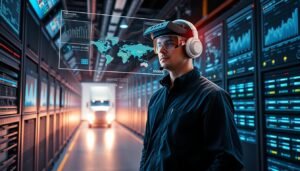Welcome to the world of machine learning. Here, data classification opens up many possibilities. At its core is the Naive Bayes algorithm, a classification technique known for its simplicity and skill. This Naive Bayes tutorial is for those starting their data science journey. It makes Naive Bayes for beginners a real gateway to mastering text classification.
We’ll explore why Naive Bayes is a top choice in supervised learning. It’s fast and reliable, making it perfect for many tasks, like Natural Language Processing (NLP). We’ll dive into text classification, sentiment analysis, and spam detection, where Naive Bayes shines.
By the end of this tutorial, the mystery of Naive Bayes will be solved. Its real-world uses will be Naive Bayes explained, making it clear and simple.
Key Takeaways:
- Insight into the versatile application of Naive Bayes in machine learning.
- Fundamentals of the powerful yet straightforward Naive Bayes classifier.
- Preview of how Naive Bayes can be instrumental for text classification and more.
- Why Naive Bayes is considered a fast and reliable classification technique.
- Introduction to the utility of Naive Bayes in NLP, setting the stage for in-depth learning.
Introduction to the Naive Bayes Classifier:
The Naive Bayes classifier is a key example of Bayesian classification. It uses a simple yet effective probability model for predictions. Its roots are in classical statistics, but it’s also key in nlp algorithm and Naive Bayes machine learning.
This classifier’s history goes back to Reverend Thomas Bayes in the 1700s. It assumes features in a dataset are independent. This simplicity helps it work well with many data types and sizes.
- The classifier bases event probability on prior knowledge of related conditions.
- It’s used in Bayesian classification for tasks like spam detection and sentiment analysis.
- Its skill in text categorization makes it a top choice for nlp algorithm.
Let’s compare Naive Bayes with another probability model in machine learning:
| Feature | Naive Bayes | Other Models |
|---|---|---|
| Data Requirements | Small to moderate | Large datasets needed |
| Assumption of Independence | Yes | No |
| Computation Complexity | Low | High |
| Use in NLP | Highly favoured | Varies |
As an nlp algorithm, Naive Bayes is great for many natural language tasks. This shows its flexibility and efficiency in real-world use. Its role in Naive Bayes machine learning frameworks highlights its value and future in predictive analytics.

Understanding the Math Behind Bayes Theorem:
The Bayes theorem is key in making classification algorithms like Naive Bayes. This part explains the math behind it. It shows how Bayes theorem is essential for Naive Bayes implementation.
Probability Basics:
Bayes theorem uses conditional probability. It finds the chance of one event happening if another has occurred. This idea is important for using Naive Bayes features in different areas.
Bayes Theorem in Action:
Bayes theorem is used in many fields, like email filtering. It helps sort emails as spam or not by updating probabilities with keyword presence. Learn more about linear regression and predictive analytics here: detailed guide on linear regression.
| Feature | Probability of Spam | Probability of Not Spam |
|---|---|---|
| Word: “Free” | 0.8 | 0.2 |
| Word: “Meeting” | 0.1 | 0.9 |

This image shows how Bayes theorem works in Naive Bayes implementation. It makes a probability model more effective.
Naive Bayes Features and Implementation:
The Naive Bayes features are known for their simplicity and effectiveness. They work well with Python’s sklearn naive bayes library. Naive Bayes is great for many classification tasks because it’s easy to use and gives good results.
Setting up the Naive Bayes algorithm is straightforward, thanks to sklearn naive bayes in Python. This makes it perfect for both beginners and seasoned programmers.
Before starting, it’s important to prepare your data. The Naive Bayes features need all predictors to be independent. After preparing your data, pick the right model from sklearn naive bayes. You might choose GaussianNB, MultinomialNB, or BernoulliNB based on your data’s distribution.
| Feature Type | Applicable Model | Use Case |
|---|---|---|
| Continuous | GaussianNB | Real-valued features like heights, weights |
| Count | MultinomialNB | Word counts in text classification |
| Binary | BernoulliNB | Yes/No features, e.g., word presence |
Knowing when and how to use these models is key for a good Naive Bayes implementation. Each model is suited for different data types and can greatly improve your prediction accuracy.
For example, using MultinomialNB with sklearn naive bayes for text classification is straightforward. You import MultinomialNB, fit it to your training data, and then make predictions on new data. This shows how naive bayes python is versatile and powerful in data science.
Developers and data scientists can use Naive Bayes features efficiently with sklearn naive bayes. This provides a solid framework for solving complex problems in a simple and effective way.
The simplicity of Naive Bayes and the strong tools in Python’s ecosystem, like sklearn naive bayes, make it a great choice for many machine learning tasks.
Exploring Different Types of Naive Bayes Models:
The Naive Bayes model is very flexible. It comes in different types like Gaussian, multinomial and bernoulli. Each one is made for specific kinds of data. This makes the model very good at sorting data correctly.
Gaussian Naive Bayes:
Gaussian naive bayes works well with data that has numbers. It thinks the numbers follow a normal pattern. This is great for finance, where numbers change all the time.
Multinomial Naive Bayes:
Multinomial naive bayes is perfect for data that can only be one thing at a time. It’s often used for text, where it looks at how often words appear. It then guesses what the text is about based on these counts.
Bernoulli Naive Bayes:
Bernoulli naive bayes is for data that can only be yes or no. It’s really good at finding spam emails. It looks at if certain words are there or not to decide if an email is spam.
| Model Type | Feature Nature | Common Applications |
|---|---|---|
| Gaussian Naive Bayes | Continuous | Financial Forecasting |
| Multinomial Naive Bayes | Discrete | Text Classification |
| Bernoulli Naive Bayes | Binary | Spam Detection |
Knowing what each naive bayes model can do helps experts pick the right one. Whether it’s text, yes/no questions, or numbers, there’s a model for it. This makes it easier to get accurate results.
Naive Bayes in Text Classification and NLP:
Naive Bayes has greatly impacted text classification in Natural Language Processing (NLP). It’s used a lot in big data environments. This includes areas like sentiment analysis and spam detection.
Sentiment Analysis:
Sentiment analysis uses Naive Bayes to understand emotions in text. It’s key for businesses to know what people think about their products. Naive Bayes looks at lots of text to find out if it’s positive, negative, or neutral.
This method is good at handling big, complex data. It’s used in user reviews and social media posts.
Spam Detection:
Naive Bayes is also used to catch spam emails. Email providers use it to sort out good emails from bad ones. It looks at word frequencies and types to spot spam patterns.
This shows Naive Bayes is great at text analysis. It provides quick, useful solutions.
| Feature | Application in Sentiment Analysis | Application in Spam Detection |
|---|---|---|
| Classification speed | Fast processing of customer feedback | Quick filtering of bulk emails |
| Data handling capacity | Manages large datasets from social media | Efficiently processes numerous emails |
| Accuracy | Highly accurate in identifying sentiment polarity | Effectively distinguishes spam from legitimate emails |
Steps for Building a Naive Bayes Classifier:
To build a Naive Bayes classifier, a key classification technique in supervised learning, follow a detailed process. This method improves the classifier’s accuracy and shows its simplicity compared to models like logistic regression.
- Data Preprocessing: Start by collecting and cleaning your data. It’s important to deal with missing values, remove noise, and make the data consistent.
- Feature Selection: Pick features that really matter for the output. Features that don’t matter can hurt the model’s performance.
- Model Training: Split your data into training and testing sets, usually 70:30. Use the training set to train your Naive Bayes classifier.
- Model Testing: Test the classifier with the testing set to see how well it works. This step is key to make sure it can handle new data.
- Performance Tuning: Adjust the model to improve its accuracy. You might need to tweak smoothing techniques and feature selection.
This classifier needs less data and is quicker than logistic regression. This makes it great when speed and efficiency are important. Here’s how Naive Bayes compares to logistic regression:
| Feature | Naive Bayes | Logistic Regression |
|---|---|---|
| Data Requirement | Less data needed | Requires more data for stability |
| Computation Speed | Faster | Relatively slower |
| Ease of Implementation | Simpler, straightforward | More complex |
| Handling of Categorical Data | Directly handles categorical data | Requires dummy variables |
Creating a Naive Bayes classifier is both an art and a science. It requires careful data selection and processing, strategic model setup, and fine-tuning based on results. This process shows why It is valued in supervised learning. By understanding its differences and similarities with naive bayes vs logistic regression, experts can use it to its fullest in different scenarios.
The Algorithm’s Assumptions and Their Real-World Impact:
When we look at the Naive Bayes algorithm, it’s key to understand its Naive Bayes assumptions. These assumptions are what make the algorithm work well. The main one is that all features it looks at are independent from each other. This makes the algorithm simple and fast, but knowing its limits is important for using it right.
Understanding Naive Bayes’ Independence Assumption:
The Naive Bayes algorithm works well because it assumes features are independent. This makes predictions fast and accurate, even with lots of data. But, this simplicity can also be a problem. It ignores any connections between features, which might make it less accurate in some cases.
When to Use Naive Bayes:
Naive Bayes is great when features are mostly independent and speed matters. It’s often used in email spam detection and analyzing social media text. Its simplicity also makes it a good starting point for more complex tasks.
Knowing the good and bad sides of Naive helps a lot. It’s good for big datasets and can handle many classes. But, it struggles with data that has strong connections between features.
For example, comparing Naive Bayes to SVM shows their differences. SVM is better when features are complex and connected. But Naive Bayes is faster and simpler for independent features. Choosing the right algorithm depends on the data and resources available.
Understanding these differences helps in picking the best algorithm for machine learning projects. This affects how well we can predict outcomes and make decisions based on data.
| Feature | Naive Bayes | SVM |
|---|---|---|
| Prediction Speed | High | Medium to High |
| Handling Large Data Sets | Excellent | Good |
| Performance with Independent Features | Excellent | Good |
| Complexity | Low | High |
| Requirement of Data Preprocessing | Low | High |
The trade-off between simplicity and precision is a big challenge in machine learning. The Naive Bayes assumptions are key to this ongoing debate.
Naive Bayes vs. Other Classification Techniques:
Naive Bayes classification is often chosen for its simplicity and speed. It’s important to compare it with logistic regression and support vector machines (SVM) to see its strengths and weaknesses.
Naive Bayes vs Logistic Regression: Logistic regression is used for binary classification tasks. Naive Bayes uses Bayes’ theorem and assumes features are independent. Logistic regression uses a logistic function and is better for numerical data.
Naive Bayes vs SVM: Support Vector Machines work well in high-dimensional spaces. They are more robust against overfitting than Naive Bayes, which assumes feature independence.
Comparing these algorithms requires looking at real-world performance metrics. For more information, check out this guide.
| Algorithm | Best Use Case | Limitations |
|---|---|---|
| Naive Bayes | Text classification, spam detection | Assumes feature independence; poor estimator |
| Logistic Regression | Medical fields, binary classification | Requires large sample size; prone to overfitting |
| Support Vector Machine | Image recognition, bioinformatics | Intensive computation; not suitable for large datasets |
Naive Bayes, logistic regression, and SVM each have their own advantages and disadvantages. Naive Bayes is great for quick analysis and datasets with independent features. But for complex scenarios, logistic regression or SVM might be better.
Evaluating the Performance of Naive Bayes Models:
When we look at Naive Bayes performance, it’s key to use different metrics. These metrics show what the model does well and what it doesn’t. We need to see how gaussian naive bayes, multinomial naive bayes, and bernoulli naive bayes do with different data.
Important metrics include confusion matrices, precision, recall, and the F1 score. Precision tells us how accurate the model is with positive predictions. Recall shows how well the model finds all relevant cases. The F1 score is a balance between precision and recall.
- Confusion Matrices: Helps in visualizing the performance of the Naive Bayes model in correctly or incorrectly classifying cases.
- Precision: Crucial for applications where the cost of false positives is high.
- Recall: Important in scenarios where missing out on true positives bears significant consequences.
- F1 Score: Useful in comparing two models that have different precision and recall levels.
The table below shows typical use cases and performance metrics for each Naive Bayes model. It helps us choose the right model for specific tasks.
| Model Type | Use Case | Precision | Recall | F1 Score |
|---|---|---|---|---|
| Gaussian Naive Bayes | Data with a normal distribution | High | Medium | High |
| Multinomial Naive Bayes | Text classification | Medium | High | Medium |
| Bernoulli Naive Bayes | Binary data | Low | Low | Low |
Choosing the right model and metrics is all about the data. By testing each model with the right metrics, developers can get the best Naive Bayes performance for their apps.
Conclusion:
Our journey through Naive Bayes has shown its power in classification. It’s simple yet effective, making it great for many tasks. This includes sentiment analysis and medical diagnosis.
Naive Bayes is known for its ability to learn from data. It’s a key tool for data scientists and machine learning experts. This is why it’s so popular. If you want to use Naive Bayes, there are many examples online. The scikit-learn library is a great place to start. It makes it easy to use Naive Bayes for your projects.
Bayesian models combine probability and statistics to make sense of data. This journey has just begun. Naive Bayes can help you explore and understand data better.
Bayesian classification is simple yet powerful. It’s used in many areas, from research to business. With Naive Bayes, you can turn data into useful decisions for the future.
FAQ:
What is Naive Bayes in machine learning?
Naive Bayes is a machine learning algorithm for classifying data. It uses Bayes’ theorem, assuming each feature is independent. This makes it fast and efficient, perfect for big datasets and quick analysis.
Why is the “naive” in Naive Bayes?
The “naive” part comes from its simple assumption. It thinks all features are independent, which is rarely true in real life. Yet, Naive Bayes often works well despite this.
What are the main types of Naive Bayes models?
There are three main types. Gaussian Naive Bayes works with normally distributed data. Multinomial Naive Bayes is for counting words in documents. Bernoulli Naive Bayes handles binary features.
Is Naive Bayes good for text classification?
Yes, it’s great for text classification. It’s fast and can handle lots of different words. It’s used for spam detection and analyzing sentiment in text.
How does Naive Bayes compare to other classification techniques?
Naive Bayes is known for its simplicity and speed. It might not always beat more complex models like SVMs. But, it’s very good with large datasets.
Can I use Naive Bayes for a beginner machine learning project?
Absolutely! It’s perfect for beginners. It’s easy to use and there are many resources available. Libraries like scikit-learn make it even simpler.
What are the performance evaluation metrics for Naive Bayes?
You can check its performance with metrics like accuracy and F1 score. These show how well it classifies data correctly.
Are there circumstances where Naive Bayes should not be used?
While versatile, Naive Bayes isn’t for every situation. It struggles with correlated features or when the independence assumption fails. More complex models might be better if you need high accuracy.
How is Bayes Theorem applied in Naive Bayes?
Bayes Theorem is used to find the probability of a class given features. Naive Bayes simplifies this by assuming feature independence. This makes it easier to predict the most likely class.
Can Naive Bayes handle continuous data?
Yes, Gaussian Naive Bayes is designed for continuous data. It assumes the data follows a normal distribution.






















1 thought on “Naive Bayes Explained: A Simple and Effective Classification Algorithm”
Awesome article to learn naive-bayes